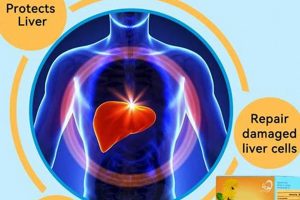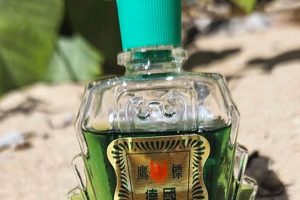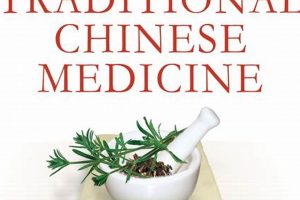Certain traditional preparations derived from botanical sources in China have been employed in the management of skin conditions characterized by scaling, inflammation, and itching. These formulations typically involve a complex combination of herbs believed to possess anti-inflammatory, immunomodulatory, and antipruritic properties. The selection of specific herbs and their proportions varies considerably, depending on the practitioner’s diagnosis of the individual’s specific presentation and underlying imbalances according to Traditional Chinese Medicine (TCM) principles.
The appeal of these approaches lies in their holistic nature, often addressing not just the symptomatic manifestation on the skin but also perceived underlying systemic disharmonies. Historically, the use of such botanical remedies has been a cornerstone of dermatological care within TCM for centuries. Proponents suggest potential benefits beyond symptom relief, including modulation of the immune system and reduction of inflammation without the adverse effects sometimes associated with conventional treatments. However, rigorous scientific validation through well-designed clinical trials remains an area of ongoing research.
The subsequent sections will delve into the specific herbal components frequently encountered in these preparations, exploring their purported mechanisms of action and reviewing the existing evidence base supporting their efficacy. This exploration will also address safety considerations and potential interactions with conventional therapies, offering a balanced perspective on this treatment modality.
Considerations Regarding Traditional Chinese Botanical Approaches for Skin Conditions
The following represents key points to consider when exploring the use of traditional Chinese botanical formulations for the management of chronic skin conditions characterized by inflammation and scaling.
Tip 1: Prioritize Consultation with Qualified Practitioners: Engage with practitioners holding recognized qualifications in Traditional Chinese Medicine. This ensures proper diagnosis based on TCM principles and a personalized herbal formula selection.
Tip 2: Understand the Holistic Treatment Approach: Recognize that botanical formulations often target underlying systemic imbalances rather than solely addressing surface symptoms. Treatment duration and outcomes may vary significantly.
Tip 3: Inquire About Herbal Sourcing and Quality Control: Ensure that the practitioner utilizes herbs sourced from reputable suppliers with verifiable quality control measures. This minimizes the risk of contamination or adulteration.
Tip 4: Be Aware of Potential Interactions: Disclose all concurrent medications and supplements to the TCM practitioner. Certain herbs may interact with conventional pharmaceuticals, altering their efficacy or increasing the risk of adverse effects.
Tip 5: Start with a Low Dosage and Monitor for Reactions: Begin with a reduced dosage of the herbal formula to assess individual tolerance. Monitor closely for any adverse reactions, such as skin irritation, digestive upset, or allergic responses.
Tip 6: Maintain Realistic Expectations: Understand that improvements may be gradual and may require long-term adherence to the prescribed herbal regimen. The efficacy of these approaches varies significantly from individual to individual.
Tip 7: Conduct Thorough Research: Familiarize oneself with the scientific literature surrounding the specific herbs included in the formulation. This enhances understanding of potential benefits and risks.
Tip 8: Document Progress Meticulously: Maintain a detailed record of symptom changes, medication adjustments, and any observed side effects. This information aids in monitoring treatment efficacy and identifying potential problems.
Careful consideration of these points is crucial for ensuring a safe and informed approach to incorporating traditional Chinese botanical remedies into the management of chronic skin conditions.
The subsequent discussion will explore the potential risks and side effects associated with these treatments in greater detail.
1. Herbal Composition
The specific combination of herbs within a traditional Chinese formulation is paramount in its intended therapeutic effect. These formulations are not simply collections of herbs, but rather carefully constructed prescriptions designed to address the unique presentation of the condition in each individual.
- Synergistic Interactions
Herbal prescriptions often contain multiple herbs that work synergistically. This means the combined effect is greater than the sum of their individual effects. One herb might enhance the absorption or bioavailability of another, while others may modulate its activity or mitigate potential side effects. For example, a primary herb addressing inflammation may be combined with another to protect the liver from potential toxicity.
- Herb Categories and Functions
Within a formulation, herbs are categorized according to their functions. Some may be considered “chief” herbs, directly targeting the primary symptoms, while others serve as “assistant” herbs, supporting the chief herbs’ action. “Envoy” herbs guide the effects of the formulation to specific areas of the body, and “harmonizing” herbs reduce potential disharmony between other ingredients, lessening potential adverse reactions. This categorization reflects the complexity of TCM theory.
- Dosage Considerations
Dosage is a critical aspect of herbal composition. The precise quantities of each herb in a formulation are carefully determined based on the individual’s condition, constitution, and the overall strategy of the prescription. Variations in dosage can significantly alter the intended therapeutic outcome. Too little of an herb may be ineffective, while too much may produce undesirable side effects.
- Variations Across Practitioners
It is important to note that there is not one universal formula for managing skin conditions via traditional Chinese medicine. The precise herbal composition will vary significantly depending on the practitioner’s diagnostic assessment according to TCM principles. This individualized approach is a hallmark of TCM and reflects the belief that each person presents a unique pattern of imbalance. Therefore, what works for one individual may not be appropriate for another.
The meticulous selection and combination of herbs, along with precise dosage considerations tailored to the individual’s specific presentation, are essential aspects of botanical approaches to managing skin conditions. These factors highlight the intricate nature of traditional Chinese herbal medicine and underscore the importance of consulting with a qualified practitioner for safe and effective treatment.
2. TCM Diagnosis
In Traditional Chinese Medicine (TCM), dermatological conditions are understood within a framework that considers the whole person, rather than solely focusing on localized skin manifestations. The TCM diagnosis is therefore paramount in determining the appropriate course of botanical treatment for conditions exhibiting scaling, inflammation, and pruritus. This diagnostic process involves a comprehensive evaluation encompassing observation of the skin lesions, inquiry into the patient’s medical history and lifestyle, pulse diagnosis, and tongue diagnosis. The objective is to identify the underlying patterns of disharmony that contribute to the external skin presentation. For example, a presentation involving intensely red, inflamed lesions may be attributed to “Heat in the Blood,” while a chronic, dry, and scaly presentation might suggest “Blood Deficiency” or “Blood Stasis.”
The TCM diagnosis dictates the specific herbal formulation prescribed. If a patient is diagnosed with “Heat in the Blood,” the formula will likely contain herbs with cooling and blood-clearing properties. Conversely, if “Blood Deficiency” is identified, the formulation will emphasize herbs that nourish and replenish the blood. A real-life example might involve two individuals presenting with similar-appearing skin lesions. One is diagnosed with “Damp-Heat” due to a greasy, exudative presentation and a history of dietary indiscretions, while the other is diagnosed with “Wind-Dryness” because of intense itching and a chronic, dry presentation worsened by exposure to dry environments. Each individual would receive a distinct herbal formula tailored to address the specific pattern identified in their TCM diagnosis.
Understanding the connection between TCM diagnosis and botanical treatment is crucial for both practitioners and patients. It underscores the individualized nature of TCM and highlights the importance of seeking a qualified practitioner for accurate diagnosis and personalized herbal prescription. The TCM diagnostic process is not merely a labeling exercise; it is the cornerstone upon which effective and targeted botanical therapy is built. Challenges arise when individuals self-diagnose or rely on generalized herbal remedies without the guidance of a TCM practitioner. Such approaches may prove ineffective or even detrimental, as the inappropriate use of herbs can exacerbate underlying imbalances and worsen the condition. Therefore, the TCM diagnosis is inextricably linked to the safe and effective application of botanical approaches for skin conditions.
3. Individualized Formulas
Traditional Chinese botanical approaches to managing dermatological conditions exhibiting scaling and inflammation, specifically when discussing formulations, emphasize the concept of individualized prescriptions. This approach diverges from standardized, one-size-fits-all treatments, acknowledging the nuanced presentation of each individual’s condition. The efficacy of botanical interventions is intimately linked to the degree to which the herbal formulation aligns with the specific diagnostic assessment undertaken by a qualified practitioner.
- Pattern Differentiation and Herbal Selection
The cornerstone of individualized formulas lies in the TCM diagnostic process known as pattern differentiation. This process identifies the underlying imbalances within the body that contribute to the external manifestation of the skin condition. Based on this differentiation, herbs are selected for their specific therapeutic properties, targeting not only the symptoms but also the root cause of the disharmony. For example, an individual exhibiting intense itching and dryness may be diagnosed with “Blood Deficiency with Wind,” leading to the inclusion of blood-nourishing and wind-expelling herbs in their formula. Another individual with similar skin lesions but diagnosed with “Damp-Heat” would receive an entirely different formula focused on clearing heat and resolving dampness.
- Formula Modification and Adaptation
Individualized formulas are not static prescriptions. They are often modified and adapted over time based on the patient’s response to treatment. As the underlying imbalances shift, the herbal composition is adjusted to maintain therapeutic efficacy. This dynamic approach allows for a more personalized and responsive treatment strategy. A practitioner might initially prescribe a formula focused on reducing acute inflammation, and then subsequently modify it to address residual dryness and scaling as the inflammation subsides. This ongoing adaptation ensures that the herbal intervention remains aligned with the patient’s evolving needs.
- Dosage Adjustment and Individual Sensitivity
Beyond the selection of specific herbs, dosage is also carefully considered and individualized. Factors such as body weight, age, overall constitution, and individual sensitivity to herbs influence the appropriate dosage range. Some individuals may require higher doses to achieve a therapeutic effect, while others may be more sensitive and require lower doses to avoid adverse reactions. Careful monitoring and communication between the practitioner and patient are essential for determining the optimal dosage. If a patient experiences digestive upset or other unwanted side effects, the dosage may be reduced or specific herbs may be adjusted to improve tolerability.
- Consideration of Concurrent Conditions and Medications
A comprehensive individualized approach also considers any concurrent medical conditions and medications the patient may be taking. Certain herbs may interact with conventional pharmaceuticals, altering their efficacy or increasing the risk of adverse effects. The TCM practitioner must carefully assess these potential interactions and select herbs that are safe and compatible with the patient’s existing treatment regimen. For instance, herbs with anticoagulant properties should be used with caution in patients taking blood-thinning medications. This holistic perspective ensures that the botanical intervention is integrated safely and effectively within the context of the patient’s overall health profile.
The emphasis on individualized formulas underscores the complexity and sophistication of traditional Chinese botanical medicine. It highlights the importance of seeking a qualified practitioner who can conduct a thorough TCM diagnosis, develop a personalized herbal prescription, and provide ongoing monitoring and adjustments. This approach maximizes the potential for therapeutic benefit while minimizing the risk of adverse effects.
4. Anti-inflammatory Action
Many botanicals employed within Traditional Chinese Medicine (TCM) for managing dermatological conditions, including those characterized by scaling and inflammation, are selected for their inherent anti-inflammatory properties. The inflammatory cascade, involving cytokines, chemokines, and various immune cells, plays a central role in the pathophysiology of such conditions. Therefore, modulating this inflammatory response is often a primary therapeutic target. Specific herbs, such as Scutellaria baicalensis (Huang Qin) and Glycyrrhiza uralensis (Gan Cao), are frequently incorporated into TCM formulas for their ability to inhibit the production of pro-inflammatory mediators. In TCM theory, inflammation is often viewed as a manifestation of “Heat” or “Toxins,” and these herbs are believed to clear Heat and resolve Toxins, thereby reducing inflammation.
The inclusion of anti-inflammatory herbs in TCM prescriptions is not arbitrary; it is guided by the TCM diagnostic assessment, which identifies the specific patterns of disharmony contributing to the inflammation. For example, if a patient presents with intensely red, inflamed lesions accompanied by a rapid pulse, the TCM diagnosis might be “Heat in the Blood.” In this case, herbs with cooling and blood-clearing properties, such as Rehmannia glutinosa (Sheng Di Huang) and Paeonia suffruticosa (Mu Dan Pi), would be selected to address both the inflammation and the underlying pattern. The effectiveness of this approach hinges on accurate pattern differentiation and the precise combination of herbs that target the specific inflammatory pathways involved. While individual herbs may possess demonstrable anti-inflammatory effects in vitro and in vivo, their synergistic action within a complex TCM formula can enhance their therapeutic potential.
Understanding the anti-inflammatory action of specific herbs used in TCM formulas is crucial for both practitioners and patients. It allows for a more informed assessment of the potential benefits and limitations of this treatment modality. While TCM offers a holistic approach that addresses underlying imbalances, the targeted use of anti-inflammatory herbs provides a mechanism for directly modulating the inflammatory response in dermatological conditions. However, it is essential to acknowledge that the scientific evidence supporting the anti-inflammatory effects of many TCM herbs remains limited, and further research is needed to fully elucidate their mechanisms of action and clinical efficacy. Furthermore, while offering potential benefits, they should always be used under the guidance of a qualified practitioner to mitigate potential risks and ensure appropriate application.
5. Immune Modulation
The pathogenesis of conditions exhibiting scaling and inflammation involves complex interactions within the immune system. Dysregulation of immune responses, characterized by an overproduction of pro-inflammatory cytokines and aberrant T-cell activity, contributes significantly to the chronic inflammatory state observed in affected tissues. Consequently, therapeutic strategies targeting immune modulation have become a focus in the management of such conditions. Certain herbal formulations, utilized within Traditional Chinese Medicine (TCM), are hypothesized to exert their therapeutic effects, at least in part, through modulating various aspects of the immune system. For instance, some herbs are believed to influence cytokine production, shifting the balance from pro-inflammatory to anti-inflammatory mediators. Others may affect the activity of specific immune cell populations, such as T-helper cells or regulatory T cells, thereby restoring immune homeostasis. Examples of herbs purported to possess immunomodulatory properties include Astragalus membranaceus (Huang Qi) and Ganoderma lucidum (Ling Zhi), although the specific mechanisms of action and the extent of their clinical efficacy remain subjects of ongoing investigation.
The importance of immune modulation as a component of TCM therapeutic approaches lies in the potential to address the underlying immunological dysregulation that perpetuates the inflammatory cycle. While conventional treatments often focus on suppressing inflammation, immunomodulatory herbs are thought to re-establish a more balanced immune response, potentially leading to longer-term remission and reduced reliance on immunosuppressive agents. Consider two individuals with similar skin manifestations; one receives a conventional treatment aimed at suppressing inflammation, while the other receives a TCM formulation designed to modulate immune function. The individual receiving the conventional treatment may experience rapid symptom relief, but the inflammation may recur upon cessation of treatment. In contrast, the individual receiving the TCM formulation may experience a more gradual improvement, but the modulated immune response may contribute to sustained symptom control. This example illustrates the potential benefits of addressing the underlying immunological imbalances rather than solely focusing on symptomatic relief.
The practical significance of understanding the connection between immune modulation and TCM approaches lies in informing the development of more targeted and effective therapeutic strategies. By elucidating the specific mechanisms by which herbal formulations influence the immune system, researchers can identify key targets for drug development and refine existing TCM practices. However, it is crucial to acknowledge the challenges associated with studying the complex interactions between multiple herbs and the immune system. Rigorous scientific investigations, including well-designed clinical trials, are needed to validate the immunomodulatory effects of TCM formulations and to determine their clinical efficacy. Furthermore, safety considerations are paramount, as some herbs may possess immunosuppressive properties that could increase the risk of infection or other adverse effects. Therefore, the application of TCM approaches for immune modulation should be undertaken under the guidance of qualified practitioners, with careful consideration of potential risks and benefits.
6. Safety Profiles
The assessment of safety profiles is a critical aspect of utilizing traditional Chinese botanical formulations for dermatological conditions. The complex composition of these herbal remedies, often involving multiple ingredients, necessitates a thorough understanding of potential adverse effects, interactions, and contraindications to ensure patient well-being.
- Herbal Quality and Authentication
The authenticity and quality of herbal ingredients directly influence safety profiles. Adulteration, misidentification, or contamination with heavy metals, pesticides, or other toxins can pose significant risks. Reputable practitioners source herbs from suppliers with stringent quality control measures, including botanical authentication and testing for contaminants. For example, the misidentification of Aristolochia species, known nephrotoxins, as other herbs has led to severe adverse events. Thus, reliable sourcing is paramount.
- Individual Sensitivities and Allergic Reactions
Individual sensitivities and allergic reactions to specific herbs represent a potential safety concern. Patients with known allergies should be carefully screened, and even those without prior allergic history can develop reactions. Symptoms may range from mild skin irritation to severe anaphylaxis. A test dose of the herbal formulation is sometimes administered to assess tolerance. An individual sensitive to plants in the Asteraceae family, such as ragweed, may also exhibit allergic reactions to herbs like Arnica montana, commonly used in topical preparations.
- Herb-Drug Interactions
Potential interactions between herbal remedies and conventional pharmaceuticals pose a significant safety challenge. Certain herbs can affect drug metabolism, absorption, or excretion, leading to altered drug efficacy or increased toxicity. Patients taking medications such as anticoagulants, immunosuppressants, or anti-diabetic agents require careful monitoring when using herbal formulations. For instance, Ginseng may interact with warfarin, affecting blood clotting, while St. John’s Wort can interfere with the efficacy of certain antidepressants.
- Practitioner Expertise and Dosage Control
The expertise of the prescribing practitioner and precise dosage control are essential for mitigating safety risks. Qualified practitioners conduct thorough patient assessments, considering individual constitution, medical history, and concurrent medications. Dosage is carefully adjusted to minimize potential adverse effects while maximizing therapeutic benefit. Overuse or inappropriate combination of herbs can lead to toxicity. Unlike standardized pharmaceutical dosages, herbal dosages often require individualization, necessitating skilled clinical judgment.
These facets underscore the importance of a comprehensive approach to evaluating safety profiles when considering traditional Chinese botanical interventions. While these modalities may offer potential benefits, a thorough understanding of potential risks and the implementation of appropriate safeguards are crucial for ensuring patient safety and optimizing treatment outcomes.
7. Research Evidence
The scientific validation of traditional Chinese botanical approaches for dermatological conditions characterized by scaling and inflammation is dependent on rigorous research evidence. A direct correlation exists between the availability of high-quality clinical trials and the acceptance and integration of these therapies into mainstream medical practice. The absence of robust evidence necessitates cautious interpretation of anecdotal reports and traditional uses, and should not be a substitute for conventional treatments without professional oversight. The practical impact is that without sufficient evidence, practitioners are limited in their ability to confidently recommend these treatments and patients lack the assurance of established efficacy and safety.
The importance of research evidence is amplified by the complexity of botanical formulations and the individualized nature of their application. Unlike single-compound pharmaceuticals, herbal remedies often contain dozens of bioactive constituents, making it challenging to isolate specific mechanisms of action and determine the contribution of each ingredient. Furthermore, Traditional Chinese Medicine diagnostic methods and individualized prescription strategies differ substantially from standardized clinical protocols, requiring specialized research designs to accurately assess treatment outcomes. For instance, a systematic review of randomized controlled trials evaluating a specific herbal formula for dermatological condition may reveal inconsistent results due to variations in diagnostic criteria, formula composition, and outcome measures across studies. This variability underscores the need for standardized research methodologies and larger, well-designed clinical trials to provide more definitive evidence.
In conclusion, the level of research evidence significantly influences the perceived credibility and clinical utility of traditional Chinese botanical approaches for conditions of inflammation and scaling. While historical use and preliminary studies may suggest potential benefits, definitive conclusions regarding efficacy and safety require rigorous scientific validation. The practical challenge lies in conducting high-quality research that addresses the complexities of herbal formulations and individualized treatment strategies. The future of this field hinges on the generation of robust evidence that can inform clinical decision-making and facilitate the integration of effective and safe botanical therapies into the broader landscape of dermatological care.
Frequently Asked Questions Regarding Chinese Herbal Approaches for Skin Conditions
The following questions address common inquiries and concerns regarding the use of traditional Chinese botanical interventions for the management of skin conditions characterized by scaling, inflammation, and itching.
Question 1: What constitutes a qualified practitioner capable of prescribing formulations based on Traditional Chinese Medicine principles?
A qualified practitioner typically holds certifications from recognized Traditional Chinese Medicine (TCM) governing bodies. These credentials signify completion of extensive training in TCM theory, diagnostics, herbal pharmacology, and clinical practice. Licensure requirements vary by jurisdiction, so verification of credentials is recommended.
Question 2: How does the TCM diagnostic process differ from conventional dermatological assessment?
Conventional dermatology primarily focuses on identifying specific skin lesions and underlying pathological processes through physical examination and diagnostic tests. TCM diagnosis, in contrast, emphasizes identifying patterns of disharmony within the entire individual, considering factors beyond the skin, such as pulse quality, tongue appearance, and lifestyle influences.
Question 3: Is there scientific evidence to support the effectiveness of these botanical approaches?
The volume and quality of scientific evidence supporting the efficacy of Chinese herbal formulations vary. Some herbs have demonstrated anti-inflammatory or immunomodulatory effects in laboratory studies and clinical trials. However, rigorous, large-scale clinical trials are often lacking. A cautious approach to evaluating evidence is advised.
Question 4: What are potential risks or side effects associated with these treatments?
Potential risks include allergic reactions, herb-drug interactions, and adverse effects due to improper herb identification or contamination. Consulting with a qualified practitioner and ensuring herbal sourcing from reputable suppliers are crucial for mitigating these risks. Open communication regarding all concurrent medications is essential.
Question 5: Can these herbal approaches be safely combined with conventional dermatological treatments?
Combining herbal and conventional treatments requires careful consideration and should only be done under the guidance of both a qualified TCM practitioner and a conventional dermatologist. Potential interactions between herbs and pharmaceuticals must be evaluated to avoid adverse effects or reduced efficacy of either treatment modality.
Question 6: How long does it typically take to observe noticeable improvements when using traditional Chinese herbal remedies?
The time frame for observing improvements varies significantly depending on individual factors, the severity of the condition, and the accuracy of the TCM diagnosis. Some individuals may experience noticeable changes within a few weeks, while others may require several months of consistent treatment. Realistic expectations are important.
In summary, while Chinese botanical remedies offer a potential avenue for managing skin conditions, a comprehensive understanding of the treatment approach, potential risks, and the importance of qualified guidance is crucial.
The subsequent discussion will address specific herbal ingredients frequently used in these formulations.
Conclusion
This exploration has provided an overview of traditional Chinese herbal approaches for dermatological conditions characterized by scaling, inflammation, and itching. The review emphasized the importance of accurate Traditional Chinese Medicine diagnosis, individualized herbal formulations, and careful consideration of safety profiles. The discussion also highlighted the necessity of rigorous research to validate the efficacy of these treatments and elucidate their mechanisms of action.
While such botanical interventions hold promise for some individuals, it is crucial to approach them with informed caution and under the guidance of qualified practitioners. Continued research and adherence to stringent quality control standards are essential for ensuring the safe and effective integration of these therapies into the broader landscape of dermatological care. Ultimately, a collaborative and evidence-based approach is required to optimize outcomes and minimize potential risks.







